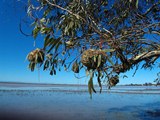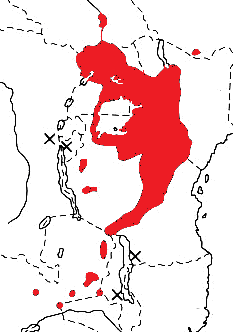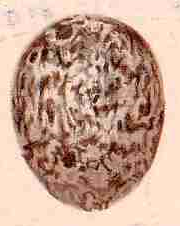Weaver species
Choose different species from drop-down list and press 'Go' button. See Full species list.Cardinal Quelea Quelea cardinalis
IUCN: Least concern Discovery: 078Categories: Quelea, nectar, pest,
News items about species
Discovery
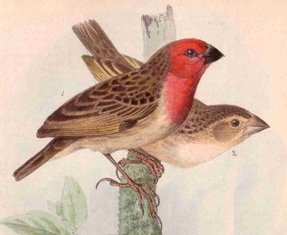
figure from Journal fur Ornithologie (1881) 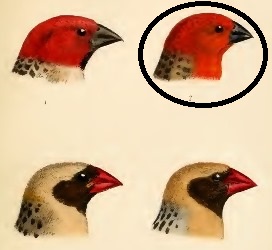
figure from Sharpe (1890), with Red-headed and Red-billed Quelea 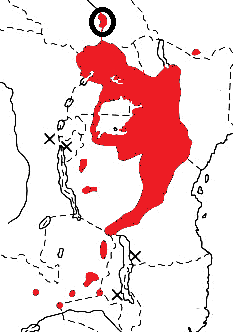
distribution, type locality circled IntroductionThe Cardinal Quelea was formally described by Karel Johan Gustav Hartlaub, a German physician and ornithologist. Hartlaub described several other weavers.The Cardinal Quelea was collected by Emin Pasha, a Ottoman-German physician, naturalist, and governor of the Egyptian province of Equatoria on the upper Nile. He collected a large number of birds in Uganda and Sudan. Emin collected a large number of male and female Cardinal Queleas around Lado in July to August 1879. The specimens were sent to Germany and through exchanges there are syntypes in various museums, including Berlin, Bremen, Bristish Museum and the American Museum of Natural History. Emin's diaries have been published, and he wrote a little over a page about the Cardinal Quelea. He noted that water was important and flocks flew to drink in the mornings and evenings. While drinking, birds also fed on insects, while they fed on grass seeds during the day. Emin also found nesting colonies in trees and noted the clutch size as 2-4. The first illustration of the Cardinal Quelea was of the type, but published in the year following the description. The second illustration for the species was published by Sharpe (1890), also showing the two previously described quelea species. Scientific citationHyphantica cardinalis Hartlaub 1880, Journ. f. Orn., 28, p.325 Lado, southern Sudan.Meaning of namescardinalis, Med. Latin: cardinalis, a cardinal, a senior bishop of the Roman church who wears scarlet robes.First English nameCardinal Dioch (Shelley 1905).Alternate namesCardinal Weaver Finch, Red-bib Quelea.CollectorEmin Pasha.Date collectedJuly to August 1879.Locality collectedLado, South Sudan.Type specimensThere are syntypes in various museums, including Berlin, Bremen, Bristish Museum and the American Museum of Natural History. |
The above is based on Weaver Wednesday 2, a weekly series about the discovery of each weaver species.
This species text first appeared as
Weaver Wednesday [195] - Discovery [78]: Cardinal Quelea on 2016-03-09
1. Basic biology
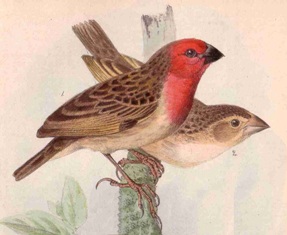
figure from 1881
Distribution. The Cardinal Quelea occurs in South Sudan, noth-eastern DRCongo, Uganda, western Kenya, Tanzania and eastern Zambia (see map right, based on Birds of Africa). No subspecies are currently recognised, although some have been proposed. Habitat. The Cardinal Quelea inhabits rank grass or tall wooded grassland, especially in dry areas rather than marshes. It is ecologically intermediate between the Red-billed Quelea which inhabits relatively arid country, and the Red-headed Quelea which occurs in high rainfall areas. It often appears after rains, especially in normally drier regions. The Cardinal Quelea is highly gregarious, often being found in large flocks but also in smaller groups. Large flocks break up into smaller groups when breeding begins. Food.
The Cardinal Quelea forages on the ground, feeding on seeds, especially grass seeds, but also takes nectar. It is a pest of agricultural crops in some parts of its range. The nestlings are fed on insects, especially caterpillars, and regurgitated seeds.
Breeding. The Cardinal Quelea is polygynous. Colony size varies from large, dense colonies to small groups of nests, to sometimes solitary nests. Colonies of several hundred nests may form in areas where they were previously unknown. The nest is a domed structure, tightly woven of grass, with a large side entrance, and no porch. It is lined with finer grass. The nest is placed between the vertical stems of grass or other vegetation, or is rarely attached to the branches of a shrub. The male builds the nest, and may complete in a day, although some nests are abndoned before completion. If a female accepts a nest, the male may construct another nest as a roost site. 2-4 eggs are laid, and they are whitish, blue or greenish and finely spotted or mottled with reddish brown or greyish mauve. Nests may be parasitized by the Diederik Cuckoo Chrysococcyx caprius. |
The above is based on Weaver Wednesday, a weekly series about weaver species.
This species text first appeared as
Weaver Wednesday [76]: Cardinal Quelea on 2013-11-27
2. Breeding facts
| Pair bond Polygynous. Colonial Breeding season Aug-Sept in DRCongo, Mar-Jul in Uganda and Kenya, Feb-May in Tanzania and Feb in Zambia Nest site placed 30 cm to 1.5 m above ground, between vertical stems of grass or other vegetation Nest building built by male, may be completed in a single day Colony size in large colonies, also in smaller groups; sometimes solitary Clutch size 2-4 Egg colour whitish with mauve spots and scrawls, or blue to greenish (rarely, pinkish) and finely mottled with reddish-brown Egg size average size of seven eggs 17.3 x 12.5 mm (Uganda) Incubation incubation by female alone, period 12-14 days Chicks and nestling period chicks fed by female alone, nestling period 16-18 days |
Breeding information based on Handbook of the Birds of the World, Vol. 15.
3. Photos of Weaver Nests
 Vm 9894 |
Thumb-nails of most recent PHOWN records - click on one to see its full record
See all PHOWN records for this species here.
PHOWN (Photos of Weaver Nests) provides valuable info on breeding distribution and colony sizes of weavers.
You can contribute by registering and submitting photos at Virtual Museum webpage.
4. Breeding distribution
Google map showing distribution (For species with small ranges you need to zoom in at the correct area to see the range):
yellow blob - range of weaver species; read more about this here.
![]() - PHOWN records with photos
- PHOWN records with photos
![]() - PHOWN records with no photos (Nest Record Cards, other records)
- PHOWN records with no photos (Nest Record Cards, other records)
![]() - Birdpix records
- Birdpix records
![]() - comments on out of range records, or interesting records
- comments on out of range records, or interesting records
![]() - type locality
- type locality
CLICK on the marker on the map to see individual record details.
5. Range changes
Not South African speciesThe above is based on Weaver Wednesday 3, a weekly series about range changes in South African weaver species.
This species text first appeared as
n/a








